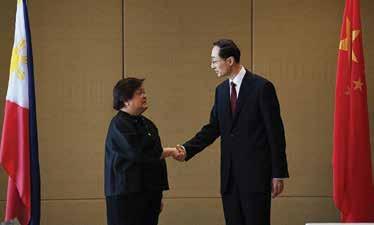
3 minute read
China, PH assess ties as sea row deepens

including the Philippines, to enhance our solidarity and cooperation, communication and coordination to jointly uphold our shared interests and peace and stability of the region," he said.
Advertisement
The territorial conflicts between the two nations have persisted as a major irritant in relations, with Manila filing at least 77 of more than 200 diplomatic protests against China's increasingly assertive actions in the disputed waters since last year alone.
That included a February 6 incident when a Chinese coast guard ship aimed a militarygrade laser that briefly blinded some crew members of a Philippine Coast Guard vessel off a disputed shoal.
Marcos summoned the Chinese ambassador to Manila to express concern over the incident, but Beijing said the Philippine vessel intruded into Chinese territorial waters and its coast guard used a harmless laser gadget to monitor the vessel's movement.
Early last month, the Marcos administration announced it would allow rotating batches of American forces to indefinitely station in four more Philippine military camps.
Those are in addition to five local bases earlier designated under a 2014 Enhanced Defense Cooperation Agreement (EDCA) between the longtime allies.
Marcos said on Wednesday, March 22 the four new military sites would include areas in the northern Philippines.
That location has infuriated Chinese officials because it would provide U.S. forces with a staging ground close to southern
China and Taiwan. The Americans would also have access to military areas in Palawan, Marcos said, adding that the US military presence under the EDCA was aimed at boosting coastal defense.
Palawan faces the South China Sea, a key passage for global trade that Beijing claims virtually in its entirety, but a United Nations-backed arbitration tribunal ruled in 2016 that the historical claim had no legal basis under the 1982 UN Convention on the Law of the Seas.
China had dismissed the ruling, which Washington and other Western governments recognize, and continues to defy it. When asked to react to the Philippine decision, Chinese Foreign Ministry spokesman Wang Wenbin told a news briefing in Beijing on Wednesday that defense cooperation between countries "needs to be conducive to regional peace and stability and not targeted at or harmful to the interests of any third party."
Wang warned countries in the region "to remain vigilant and avoid being coerced or used by the US" without naming the Philippines.
A recent statement issued by the Chinese Embassy in Manila was more blunt and warned that the Manila government's security cooperation with Washington "will drag the Philippines into the abyss of geopolitical strife and damage its economic development at the end of the day."
The Biden administration has been strengthening an arc of military alliances in the Indo-Pacific to better counter
China, including in any future confrontation over Taiwan.
The U.S. moves dovetail with Philippine efforts to shore up its territorial defense amid its disputes with China in the South China Sea.
In Beijing, the Southern Theater Command of China's People's Liberation Army (PLA) said the USS Milius, a guided missile destroyer, on Thursday entered waters around the Paracel Islands, which are also claimed by Vietnam.
The PLA "organized sea and air forces to track and monitor [the ship] in accordance with the law" and "warned it to leave," spokesman Tian Junli said.
The vessel "made an illegal incursion into Chinese territorial waters... without permission from the Chinese government, harming peace and stability" in the region, he said.
The U.S. military denied the claims, telling the Agence FrancePresse that "the PRC's statement is false," using the acronym for the People's Republic of China.
The vessel "is conducting routine operations in the South China Sea and was not expelled," said a spokesman for US IndoPacific Command. "The United States will continue to fly, sail, and operate wherever international law allows," the spokesman said.
Also on Thursday,March 23, the Philippine Coast Guard (PCG) said it deployed one of its patrol vessels to Sandy Cay and Pagasa Island in the West Philippine Sea early this week to carry out President Marcos' order to strengthen the PCG's presence in the country's exclusive economic zone (EEZ).
The PCG said the BRP Melchora Aquino spotted several Chinese vessels in the waters of Kalayaan Island Group.
The PCG also monitored eight foreign fishing vessels through its Radio Detection and Ranging and Automatic Identification System.
It made a visual confirmation that the vessels were fishing boats in Menzies Reef.
Two more foreign fishing vessels were spotted in the waters of Lawak Island.
Sandy Cay, Pag-asa Island, Menzies Reef and the islands of Lawak and Likas are located inside the 200-mile EEZ. (ManilaTimes.net with reports from Associated Press and Agence France-Presse)







